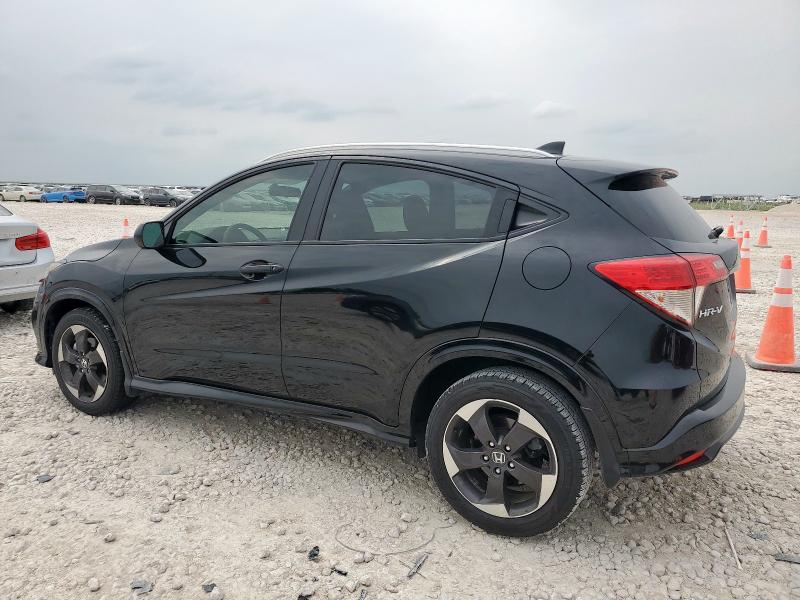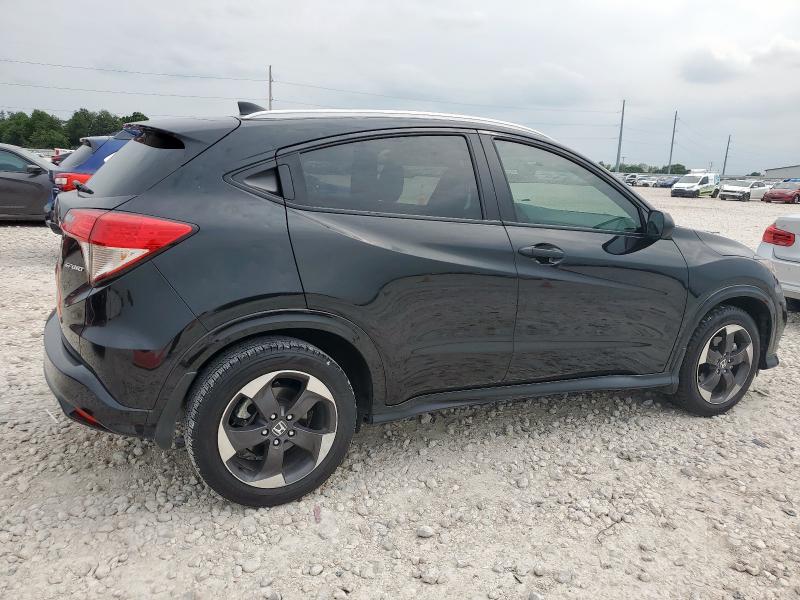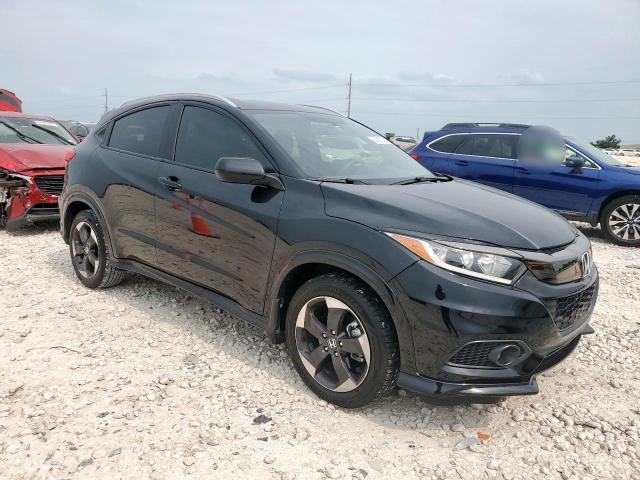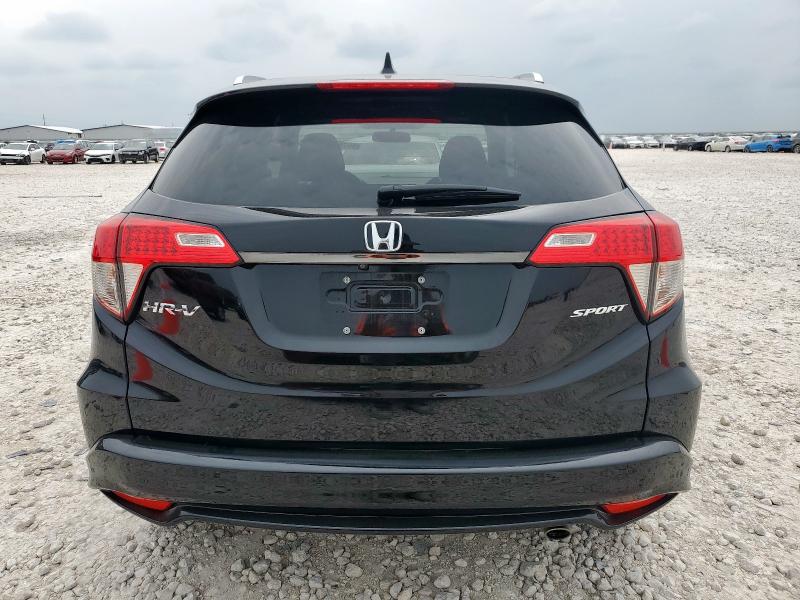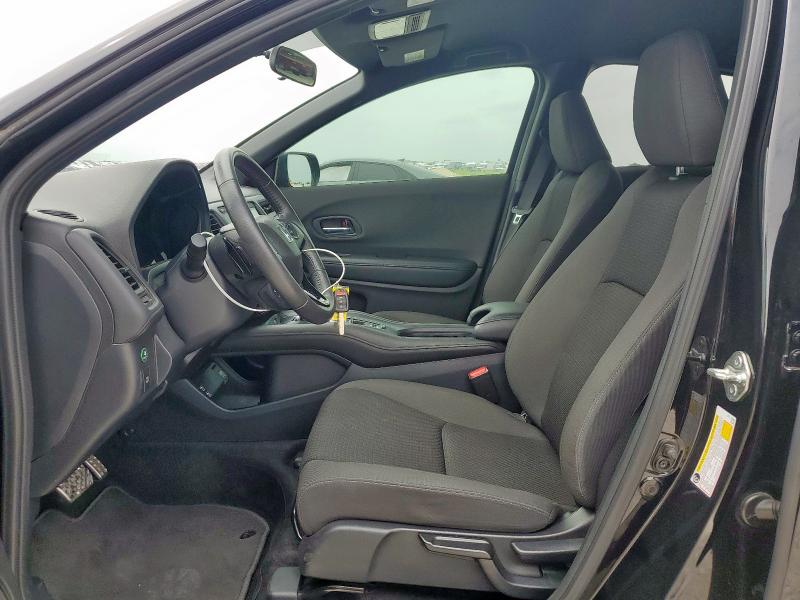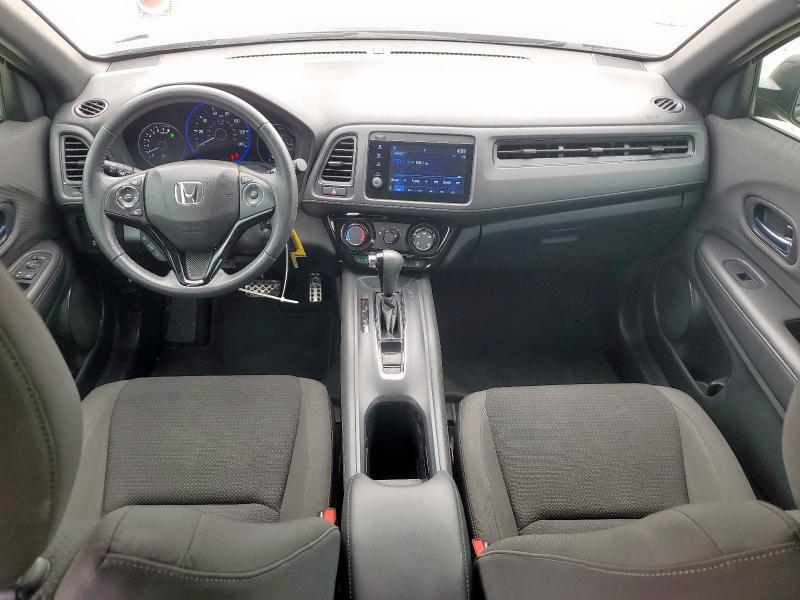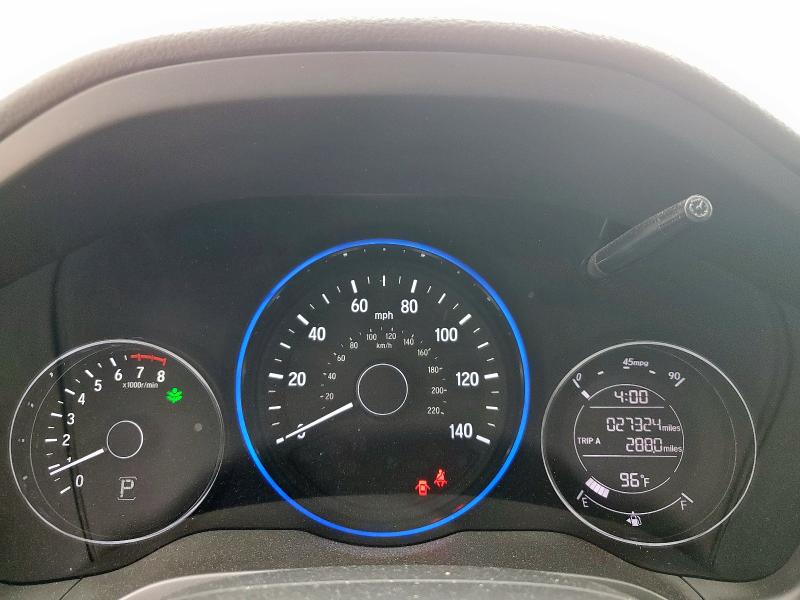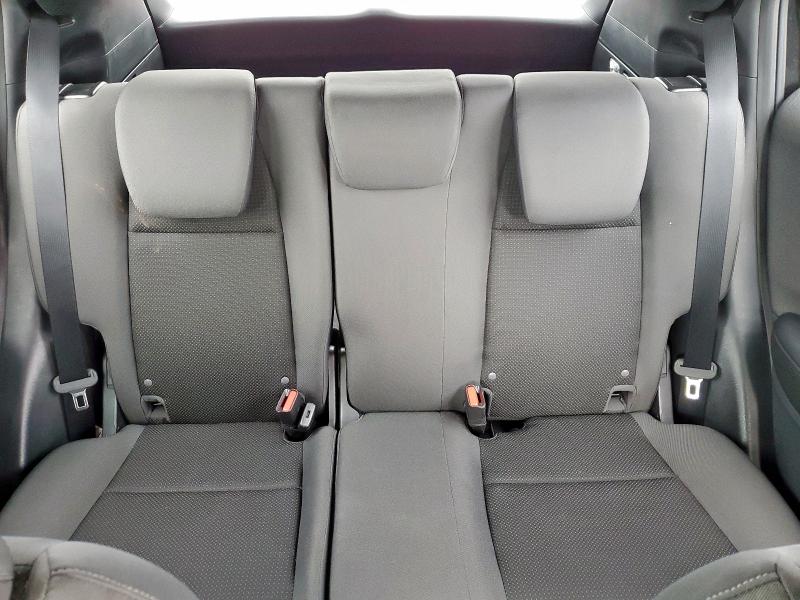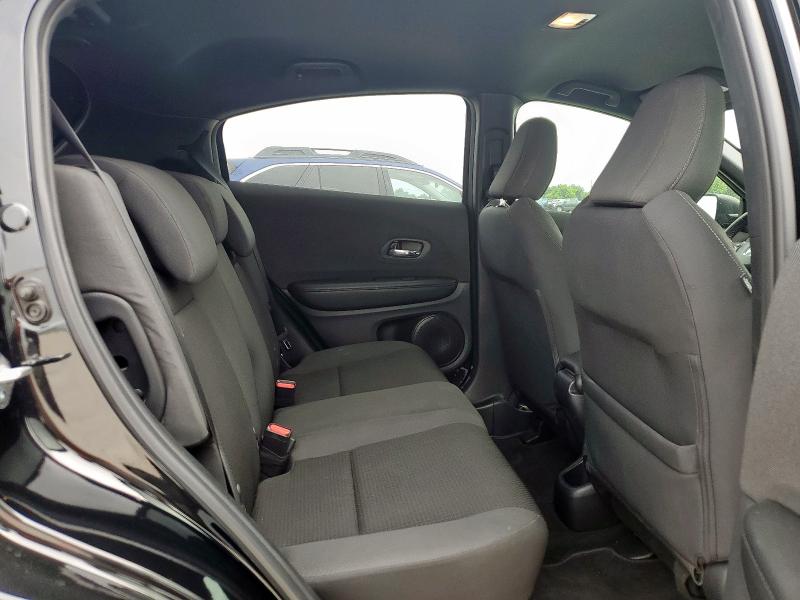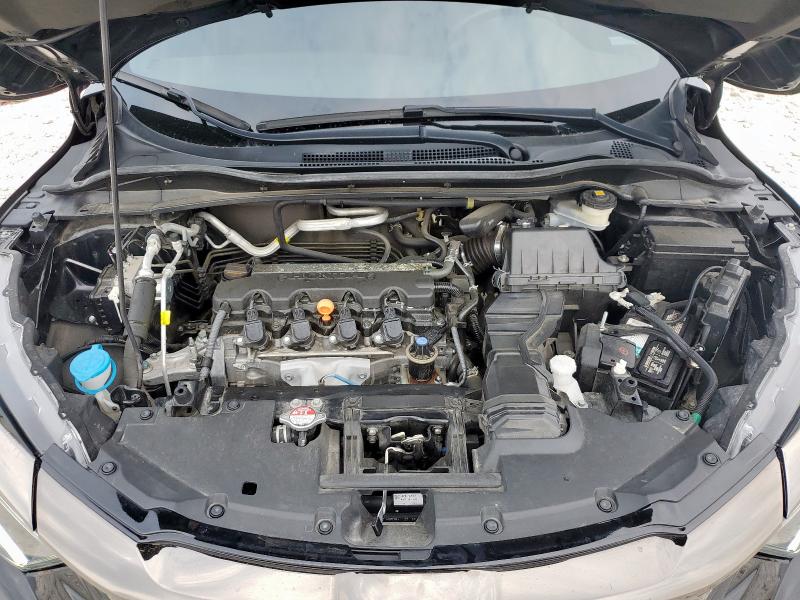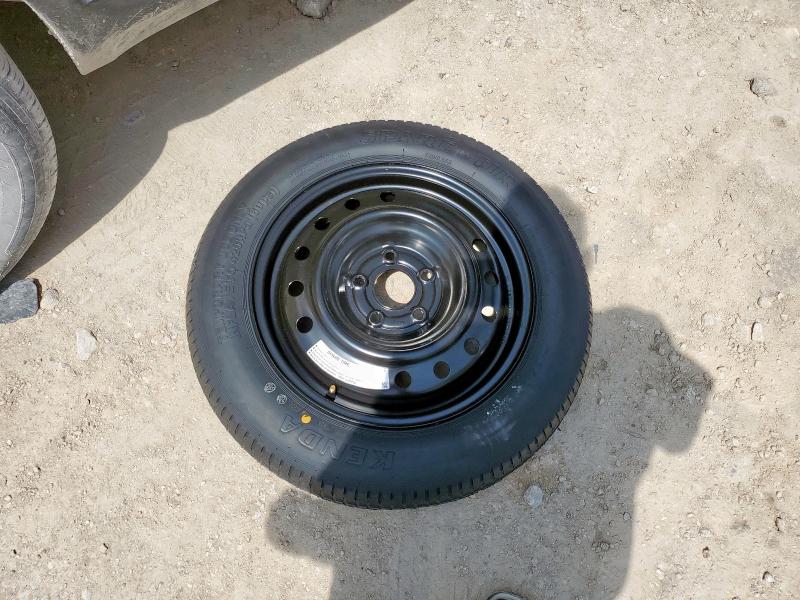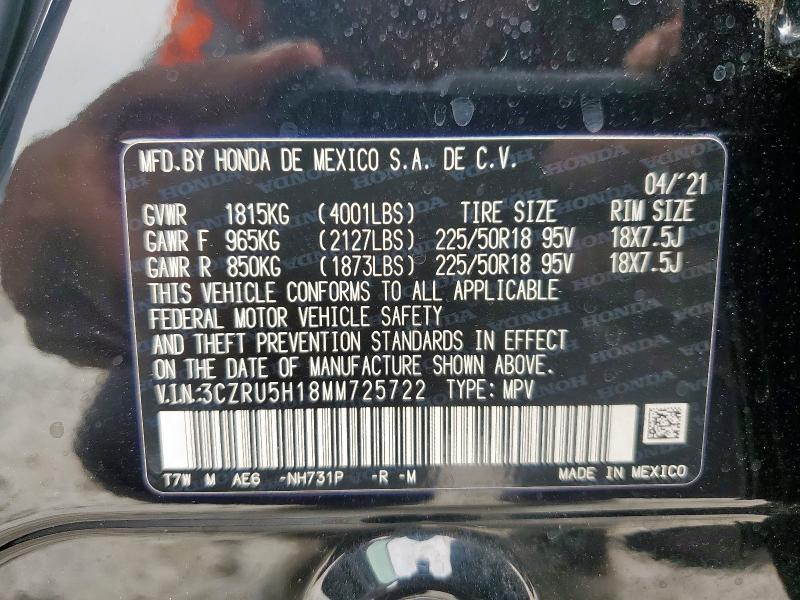2021 HONDA HR-V | 3CZRU5H18MM725722
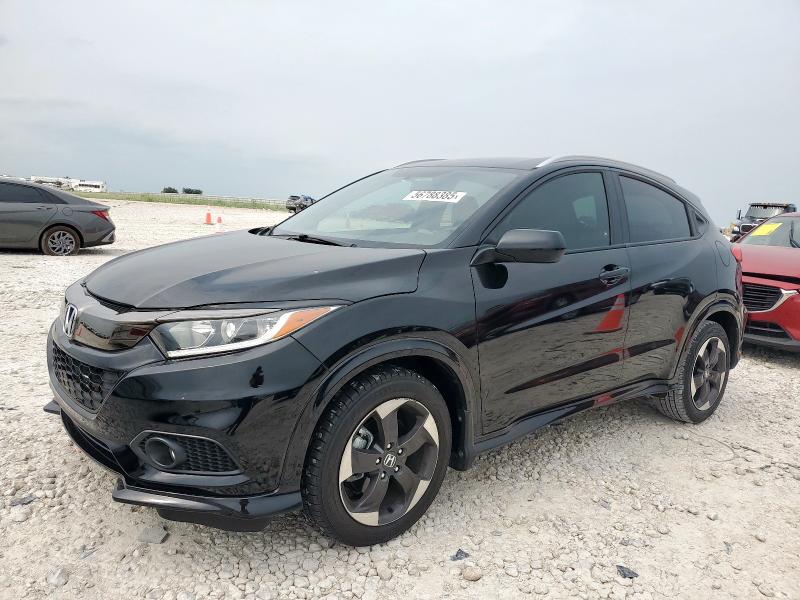 ❯
❯
Specifications
1
~$30,000
Engine: 1.8L naturally aspirated I4
Torque: 172 Nm
0–100 km/h: ~9.5 s
While not a performance SUV by design, the Honda HR-V delivered a confident and composed driving experience in its class. Powered by a 1.8-liter i-VTEC four-cylinder engine making 141 horsepower and 172 Nm of torque, it achieved 0–100 km/h in approximately 9.5 seconds with AWD. While modest on paper, the engine paired well with the HR-V’s efficient continuously variable transmission (CVT), offering smooth acceleration ideal for urban and suburban driving.
The HR-V’s compact footprint and low center of gravity contributed to nimble handling, especially around tight corners and city streets. Front MacPherson struts and a rear torsion-beam suspension delivered a stable ride, and while steering lacked the sharpness of a sportier crossover, it was responsive and predictable. The AWD system provided extra grip in wet or snowy conditions, adding to its all-weather competence.
Its sporting merit lay not in outright speed, but in versatility and precision. The HR-V could confidently navigate twisty roads, tight parking garages, and uneven surfaces, making it a strong everyday performer for drivers who wanted just enough agility and control — without compromising comfort or fuel economy.
Body Styles
The Honda HR-V was offered exclusively as a five-door subcompact crossover SUV. Designed with coupe-like proportions, it featured a sloped roofline, hidden rear door handles, and pronounced fender flares, giving it a youthful, sporty stance. Its high ride height, short overhangs, and sculpted side panels contributed to a rugged yet sleek appearance. The rear hatch offered wide access to the cargo area, while the integrated roof spoiler and horizontal taillights reinforced its urban-friendly proportions. Despite its compact size, the HR-V’s elevated seating position and spacious interior gave it true crossover practicality.
Model Name Meaning (Manufacturer)
“HR-V” stands for “Hi-rider Revolutionary Vehicle,” a name originally introduced by Honda in the late 1990s. The badge reflects the vehicle’s mission to combine SUV versatility with a small car footprint — a revolutionary concept at the time. Honda revived the name for global markets to highlight the HR-V’s blend of practicality, efficiency, and modern crossover appeal.
Body & Interior Colors and Rims
The HR-V was offered in a vibrant palette that included Aegean Blue Metallic, Crystal Black Pearl, Lunar Silver Metallic, Milano Red, White Orchid Pearl, and Modern Steel Metallic. Sport trims introduced bold options like Orangeburst Metallic and unique darkened trim elements. The body featured black plastic cladding around the wheel arches and lower rocker panels, reinforcing its crossover identity. Chrome accents were minimal but well-placed on EX-L and Touring trims, which also featured LED daytime running lights and roof rails.
Interior trims varied by model. Base LX variants included durable black or gray cloth seats, while EX-L and Touring trims offered leather upholstery in Black or Graystone, with stitched soft-touch surfaces and gloss-black or silver dashboard inserts. The cabin featured Honda’s unique “Magic Seat” system, allowing the rear seat bottoms to flip up vertically for tall cargo, or fold flat into the floor — delivering SUV flexibility in a subcompact footprint.
Wheel options included 17-inch silver-painted alloys on most trims and black-painted or machined-face wheels on Sport and Touring models. While not oversized, these wheels filled the arches neatly and were paired with all-season tires designed for comfort, fuel economy, and occasional light off-road use.
Top Expensive Options
- EX-L with Navigation Package: $1,500
- All-Wheel Drive Upgrade: $1,400
- Honda LaneWatch Blind Spot Camera: $500
- Leather-Trimmed Seats with Heated Front Row: $1,200
- Power Moonroof: $1,000
- 7-inch Display Audio Touchscreen with Apple CarPlay/Android Auto: $800
- Roof Rails and Crossbars: $500
- Automatic Climate Control with Air Filtration: $600
- Rearview Camera with Dynamic Guidelines: $400
- Cargo Tray and All-Weather Floor Mats: $300
vs Competitors
The Honda HR-V competed directly with the Mazda CX-3, Toyota C-HR, Subaru Crosstrek, Hyundai Kona, and Nissan Rogue Sport. Compared to the CX-3, it offered significantly more rear-seat and cargo space, while matching its fuel economy. Against the Toyota C-HR, the HR-V won in overall practicality and ride height but offered less visual drama. The Subaru Crosstrek had better off-road ability with standard AWD, but the HR-V provided better interior packaging and smoother urban dynamics. The Hyundai Kona was more powerful and tech-forward in upper trims, but the HR-V excelled in long-term usability, space efficiency, and resale value. It wasn’t the flashiest or quickest in its class — but as a flexible, dependable, and cleverly designed small crossover, it remained a top choice.
Fun Fact
The HR-V’s “Magic Seat” system — borrowed from the Honda Fit — gave it best-in-class cargo versatility. With the rear seats folded, it could accommodate items up to 8 feet long or 4 feet tall in upright mode, allowing it to carry bikes, houseplants, small furniture, or even surfboards with ease. This interior flexibility was a signature feature that few rivals could match, and a major reason why the HR-V remained a favorite among active, space-conscious buyers.
Lot Details
Final Bid Honda HR-V (2021)
$10,500
$11,025
$12,200
Specifications
1
~$30,000
Torque:
0–100 km/h:
While not a performance SUV by design, the Honda HR-V delivered a confident and composed driving experience in its class. Powered by a 1.8-liter i-VTEC four-cylinder engine making 141 horsepower and 172 Nm of torque, it achieved 0–100 km/h in approximately 9.5 seconds with AWD. While modest on paper, the engine paired well with the HR-V’s efficient continuously variable transmission (CVT), offering smooth acceleration ideal for urban and suburban driving.
The HR-V’s compact footprint and low center of gravity contributed to nimble handling, especially around tight corners and city streets. Front MacPherson struts and a rear torsion-beam suspension delivered a stable ride, and while steering lacked the sharpness of a sportier crossover, it was responsive and predictable. The AWD system provided extra grip in wet or snowy conditions, adding to its all-weather competence.
Its sporting merit lay not in outright speed, but in versatility and precision. The HR-V could confidently navigate twisty roads, tight parking garages, and uneven surfaces, making it a strong everyday performer for drivers who wanted just enough agility and control — without compromising comfort or fuel economy.
Body Styles
The Honda HR-V was offered exclusively as a five-door subcompact crossover SUV. Designed with coupe-like proportions, it featured a sloped roofline, hidden rear door handles, and pronounced fender flares, giving it a youthful, sporty stance. Its high ride height, short overhangs, and sculpted side panels contributed to a rugged yet sleek appearance. The rear hatch offered wide access to the cargo area, while the integrated roof spoiler and horizontal taillights reinforced its urban-friendly proportions. Despite its compact size, the HR-V’s elevated seating position and spacious interior gave it true crossover practicality.
Model Name Meaning (Manufacturer)
“HR-V” stands for “Hi-rider Revolutionary Vehicle,” a name originally introduced by Honda in the late 1990s. The badge reflects the vehicle’s mission to combine SUV versatility with a small car footprint — a revolutionary concept at the time. Honda revived the name for global markets to highlight the HR-V’s blend of practicality, efficiency, and modern crossover appeal.
Body & Interior Colors and Rims
The HR-V was offered in a vibrant palette that included Aegean Blue Metallic, Crystal Black Pearl, Lunar Silver Metallic, Milano Red, White Orchid Pearl, and Modern Steel Metallic. Sport trims introduced bold options like Orangeburst Metallic and unique darkened trim elements. The body featured black plastic cladding around the wheel arches and lower rocker panels, reinforcing its crossover identity. Chrome accents were minimal but well-placed on EX-L and Touring trims, which also featured LED daytime running lights and roof rails.
Interior trims varied by model. Base LX variants included durable black or gray cloth seats, while EX-L and Touring trims offered leather upholstery in Black or Graystone, with stitched soft-touch surfaces and gloss-black or silver dashboard inserts. The cabin featured Honda’s unique “Magic Seat” system, allowing the rear seat bottoms to flip up vertically for tall cargo, or fold flat into the floor — delivering SUV flexibility in a subcompact footprint.
Wheel options included 17-inch silver-painted alloys on most trims and black-painted or machined-face wheels on Sport and Touring models. While not oversized, these wheels filled the arches neatly and were paired with all-season tires designed for comfort, fuel economy, and occasional light off-road use.
Top Expensive Options
- EX-L with Navigation Package: $1,500
- All-Wheel Drive Upgrade: $1,400
- Honda LaneWatch Blind Spot Camera: $500
- Leather-Trimmed Seats with Heated Front Row: $1,200
- Power Moonroof: $1,000
- 7-inch Display Audio Touchscreen with Apple CarPlay/Android Auto: $800
- Roof Rails and Crossbars: $500
- Automatic Climate Control with Air Filtration: $600
- Rearview Camera with Dynamic Guidelines: $400
- Cargo Tray and All-Weather Floor Mats: $300
vs Competitors
The Honda HR-V competed directly with the Mazda CX-3, Toyota C-HR, Subaru Crosstrek, Hyundai Kona, and Nissan Rogue Sport. Compared to the CX-3, it offered significantly more rear-seat and cargo space, while matching its fuel economy. Against the Toyota C-HR, the HR-V won in overall practicality and ride height but offered less visual drama. The Subaru Crosstrek had better off-road ability with standard AWD, but the HR-V provided better interior packaging and smoother urban dynamics. The Hyundai Kona was more powerful and tech-forward in upper trims, but the HR-V excelled in long-term usability, space efficiency, and resale value. It wasn’t the flashiest or quickest in its class — but as a flexible, dependable, and cleverly designed small crossover, it remained a top choice.
Fun Fact
The HR-V’s “Magic Seat” system — borrowed from the Honda Fit — gave it best-in-class cargo versatility. With the rear seats folded, it could accommodate items up to 8 feet long or 4 feet tall in upright mode, allowing it to carry bikes, houseplants, small furniture, or even surfboards with ease. This interior flexibility was a signature feature that few rivals could match, and a major reason why the HR-V remained a favorite among active, space-conscious buyers.

